Stochastic Finite Element Analysis of Root-Reinforcement Effects in Long and Steep Slopes
Abstract
:1. Introduction
2. Materials and Methods
2.1. Mathematical Formulation
2.2. Modelling Domain and Progressive Fracture
2.3. Model Material Properties
2.4. Numerical Techniques
3. Theoretical Verification of the Model
4. Results and Discussion
4.1. Progressive Failure and the Progressive Factor of Safety
4.2. Impact of Material Variability on the Factor of Safety
5. Conclusions
- Our solution strategy efficiently incorporates soil variability and uncertainty into the analysis.
- Material properties, including Young’s modulus, cohesion, and the internal friction angle, are assigned random distributions using Monte Carlo simulations to account for inherent uncertainty.
- This approach enables a probabilistic estimation of the factor of safety, failure surface, and slope deformation by considering the effects of material heterogeneity.
- An increasing root area ratio (RAR) leads to a narrower range of population data and higher certainty, while a higher slope angle results in a wider range of sample data and increased material heterogeneity.
- Accurate predictions of the factor of safety require reliable information about material heterogeneity to account for associated uncertainty.
- We analyze the root reinforcement effects on slope stability with different root area ratios (0.6–0.8%) and slope angles (20–50°), while also considering material variability (SD: 0–10).
- Higher heterogeneity increases uncertainty, while lower heterogeneity improves certainty; this is particularly evident in stable domains with lower slope angles (20°) and higher root area ratios (0.8%).
Author Contributions
Funding
Data Availability Statement
Acknowledgments
Conflicts of Interest
References
- Corlu, C.G.; Akcay, A.; Xie, W. Stochastic simulation under input uncertainty: A Review. Oper. Res. Perspect. 2020, 7, 100162. [Google Scholar] [CrossRef]
- Aladejare, A.E.; Wang, Y. Sources of Uncertainty in Site Characterization and Their Impact on Geotechnical Reliability-Based Design. ASCE-ASME J. Risk Uncertain. Eng. Syst. Part A Civ. Eng. 2017, 3, 04017024. [Google Scholar] [CrossRef]
- Ishii, K.; Suzuki, M. Stochastic finite element method for slope stability analysis. Struct. Saf. 1986, 4, 111–129. [Google Scholar] [CrossRef]
- Bishop, A. The influence of progressive failure on the choice of the method of stability analysis. Géotechnique 1971, 21, 168–172. [Google Scholar] [CrossRef]
- Bjerrum, L. Progressive failure in slopes of overconsolidated plastic clay and clay shales. J. Soil. Mech. Found Div. 1967, 93, 1–49. [Google Scholar] [CrossRef]
- Chowdhury, R.; Zhang, S. Modelling the risk of progressive slope failure: A new approach. Reliab. Eng. Syst. Saf. 1993, 40, 17–30. [Google Scholar] [CrossRef]
- Lechman, J.; Griffiths, D. Analysis of the Progression of Failure of Earth Slopes by Finite Elements; Geo-Institut: Porta Westfalica, Germany, 2000; pp. 250–265. [Google Scholar]
- Zhang, K.; Cao, P.; Bao, R. Progressive failure analysis of slope with strain-softening behaviour based on strength reduction method. J. Zhejiang Univ. Sci. A 2013, 14, 101–109. [Google Scholar] [CrossRef]
- Deliveris, A.V.; Zevgolis, I.E.; Koukouzas, N.C. Progressive Failure of Slopes: Stochastic Simulation Based on Transition Probabilities and Markov Chains. Geotech. Geol. Eng. 2021, 39, 4491–4510. [Google Scholar] [CrossRef]
- Griffiths, D.V.; Fenton, G.A. Seepage beneath water retaining structures founded on spatially random soil. Geotechnique 1993, 43, 577–587. [Google Scholar] [CrossRef]
- Griffiths, D.V.; Fenton, G.A. Influence of soil strength spatial variability on the stability of an undrained clay slope by finite elements. In Slope Stability 2000, Proceedings of Sessions of Geo-Denver 2000, Denver, Colorado, 5–8 August 2000; ASCE: Reston, VA, USA, 2000; pp. 184–193. [Google Scholar]
- Griffiths, D.V.; Fenton, G.A. Probabilistic slope stability analysis by finite elements. J. Geoenviron. Eng. ASCE 2004, 130, 507–518. [Google Scholar] [CrossRef]
- Fenton, G.A.; Griffiths, D.V. Statistics of free surface flow through stochastic earth dam. J. Geotech. Eng. 1996, 122, 427–436. [Google Scholar] [CrossRef]
- Fenton, G.A.; Griffiths, D.V. A Slope Stability Reliability Model. In Proceedings of the K.Y. Lo Symposium, London, ON, Canada, 7–8 July 2005. [Google Scholar]
- Tonon, F.; Bernardini, A.; Mammino, A. Reliability analysis of rock mass response by means of random set theory. Reliab. Eng. Sys. Saf. 2000, 70, 263–282. [Google Scholar] [CrossRef]
- Laowattanabandit, P.; Griffiths, D.V. An Application of Probabilistic Analysis on the Stability of Simple Slope and Surface Excavation. In Proceedings of the 2nd Thailand Symposium on Rock Mechanics, Chonburi, Thailand, 12–13 March 2009; Fuenkajorn, K., Phien-Wej, N., Eds.; Pub.GMR. Institute of Engineering, Suranaree University of Technology: Nakhon Ratchasima, Thailand, 2009; pp. 235–248. [Google Scholar]
- Hicks, M.A.; Boughrarou, R. Finite element analysis of the Nerlerk underwater berm failures. Géotechnique 1998, 48, 169–185. [Google Scholar] [CrossRef]
- Hicks, M.A. Editorial, Risk and variability in geotechnical engineering. Géotechnique 2005, 55, 1–2. [Google Scholar] [CrossRef]
- Hicks, M.A.; Onisiphorou, C. Stochastic Analysis of Saturated Soils Using Finite Elements. Final Report to EPSRC; Grant No. GR/LR34662; Engineering and Physical Sciences Research Council (EPSRC), UK Research and Innovation: Swindon, UK, 2000. [Google Scholar]
- Hicks, M.A.; Onisiphorou, C. Stochastic evaluation of static liquefaction in a predominantly dilative sand fill. Géotechnique 2005, 55, 123–133. [Google Scholar] [CrossRef]
- Hicks, M.A.; Samy, K. Influence of heterogeneity on undrained clay slope stability. Q. J. Eng. Geol. Hydrogeol. 2005, 35, 41–49. [Google Scholar] [CrossRef]
- Tiwari, R.C.; Bhandary, N.P.; Yatabe, R.; Bhat, D.R. New numerical scheme in the finite element method for evaluating root-reinforcement effect on soil slope stability. Geotechnique 2013, 63, 129–139. [Google Scholar] [CrossRef]
- Waldron, L.J. The shear resistance of root-permeated homogenous and stratified soil. Soil. Sci. Am. J. 1977, 41, 843–849. [Google Scholar] [CrossRef]
- Gray, D.H.; Oshashi, H. Mechanics of fiber reinforcement in sand. J. Geotech. Eng. ASCE 1983, 109, 335–353. [Google Scholar] [CrossRef]
- Lee, I.W.Y. A review of vegetative slope stabilization. J. HongKong Inst. Eng. 1985, 3, 9–21. [Google Scholar]
- Wu, T.H.; Beal, P.E.; Lan, C. In-situ shear test of soil-root systems. J. Geotech. Eng. 1988, 114, 1377–1393. [Google Scholar] [CrossRef]
- Gray, D.H.; Sotir, R.D. Biotechnical Soil Bioengineering Slope Stabilization: A Practical Guide for Erosion Control; Wiley: New York, NY, USA, 1996. [Google Scholar]
- Coppin, N.J.; Richards, I.G. Use of Vegetation in Civil Engineering; Cambridge University Press: Cambridge, UK, 2003. [Google Scholar]
- Popescu, R.; Deodatis, G.; Nobahar, A. Effects of random heterogeneity of soil properties on bearing capacity. Probabilistic Eng. Mech. 2005, 20, 324–342. [Google Scholar] [CrossRef]
- Cho, S.E. Effects of spatial variability of soil properties on slope stability. Eng. Geol. 2007, 92, 97–109. [Google Scholar] [CrossRef]
- Chu, S.E. Probabilistic Assessment of Slope Stability That Considers the Spatial Variability of Soil Properties. J. Geotech. Geoenviron. Eng. 2010, 136, 975–984. [Google Scholar] [CrossRef]
- Huber, M.; Moellmann, A.; Bardossy, A.; Vermeer, P.A. Contributions to probabilistic soil modeling. In Proceeding of the 7th International Probabilistic Workshop, Delft, The Netherlands, 25–26 November 2009. [Google Scholar]
- Elkateb, T.; Chalaturnyk, R.; Robertson, P.K. An overview of soil heterogeneity: Quantification and implications on geotechnical field problems. Can. Geotech. J. 2003, 40, 1–15. [Google Scholar] [CrossRef]
- Hyunki, K. Spatial Variability in Soils: Stiffness and Strength. Ph.D. Thesis, Georgia Institute of Technology, Atlanta, GA, USA, 2005; pp. 15–16. [Google Scholar]
- Yu, W.; Zijun, C.; Siu-Kui, A. Practical reliability analysis of slope stability by advanced Monte Carlo simulations in a spreadsheet. Can. Geotech. J. 2011, 48, 162–172. [Google Scholar]
- Nezhad, M.M.; Javadi, A.A.; Abbasi, F. Stochastic finite element modelling of water flow in variably saturated heterogeneous soils. Int. J. Numer. Anal. Methods Geomech. 2010, 35, 1389–1408. [Google Scholar] [CrossRef]
- Liu, C.N. Landslide hazard mapping using Monte Carlo simulation a case study in Tiwan. In Geotechnical Engineering for Disaster Mitigation and Rehabilitation Part 3; Springer: Berlin/Heidelberg, Germany, 2008; pp. 189–194. [Google Scholar]
- Zhou, G.; Esaki, T.; Mitani, Y.; Xie, M.; Mori, J. Spatial probabilistic modeling of slope failure using an integrated GIS Monte Carlo simulation approach. Eng. Geol. 2003, 68, 373–386. [Google Scholar] [CrossRef]
- Matsui, T.; San, K.C. Finite element slope stability analysis by strength reduction technique. Soils Found. 1992, 32, 59–70. [Google Scholar] [CrossRef]
- Dawson, E.M.; Roth, W.H.; Drescher, A. Slope stability analysis by strength reduction. Geotechnique 1999, 49, 835–840. [Google Scholar] [CrossRef]
- Chen, J.X.; Ke, P.Z.; Zhang, G. Slope stability analysis by strength reduction elasto-plastic FEM. Key Eng. Mater. 2007, 345–346, 625–628. [Google Scholar]
- Huang, M.S.; Jia, C.Q. Strength reduction FEM in stability analysis of soil slope subjected to transient unsaturated seepage. Comput. Geotech. 2009, 36, 93–101. [Google Scholar] [CrossRef]
- Dhital, M.R.; Deoja, B.; Thapa, B.; Wagner, A. (Eds.) Mountain Risk Engineering Handbook: Vol I, Chapter 9: Soil Mechanics; ICIMOD Publications: Patan, Nepal, 1991; p. 132. Available online: https://lib.icimod.org/record/21322 (accessed on 14 August 2023).
- Krahenbuhl, J.; Wagner, A. Survey, Design, and Construction of Trail Suspension Bridges for Remote Areas; SKAT. Swiss Center for Appropriate Technology: St. Gallen, Switzerland, 1983. [Google Scholar]
- Kulhawy, F.H. Manual on Estimating Soil Properties for Foundation Design; EPRI: Palo Alto, CA, USA, 1990. [Google Scholar]
- Zaman, M.; Gopalasingam, A.; Laguros, J.G. Consolidation settlement of bridge approach foundation. J. Geotech. Eng. 1991, 117, 219–239. [Google Scholar] [CrossRef]
- Monley, G.J.; Wu, J.T.H. Tensile reinforcement effects on bridge approach settlement. J. Geotech. Eng. ASCE 1993, 119, 749–762. [Google Scholar] [CrossRef]
- Budhu, M. Soil Mechanics and Foundation; John Wiley and Sons: Hoboken, NJ, USA, 1999. [Google Scholar]
- Chung, A.K. On the boundary conditions in slope stability analysis. Int. J. Numer. Anal. Methods Geomech. 2003, 27, 905–926. [Google Scholar]
- Das, B.M. Geotechnical Earthquake Engineering; Pearson Education: Delhi, India, 2003. [Google Scholar]
- Gharti, H.N.; Komatitsch, D.; Oye, V.; Martin, R.; Tromp, J. Application of an elasto-plastic spectral-element method to 3D slope stability analysis. Int. J. Numer. Meth. Eng. 2012, 91, 1–26. [Google Scholar] [CrossRef]


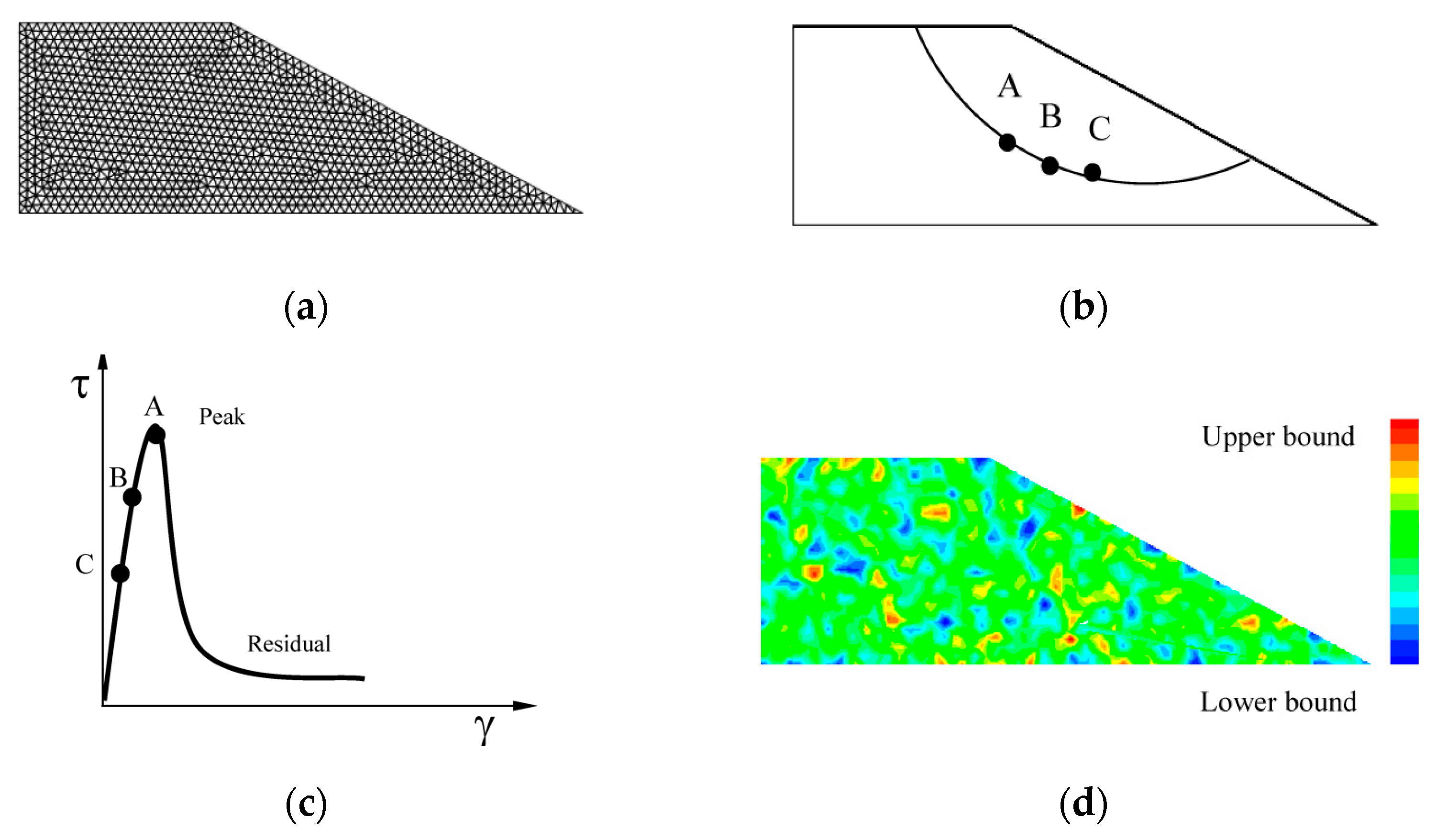

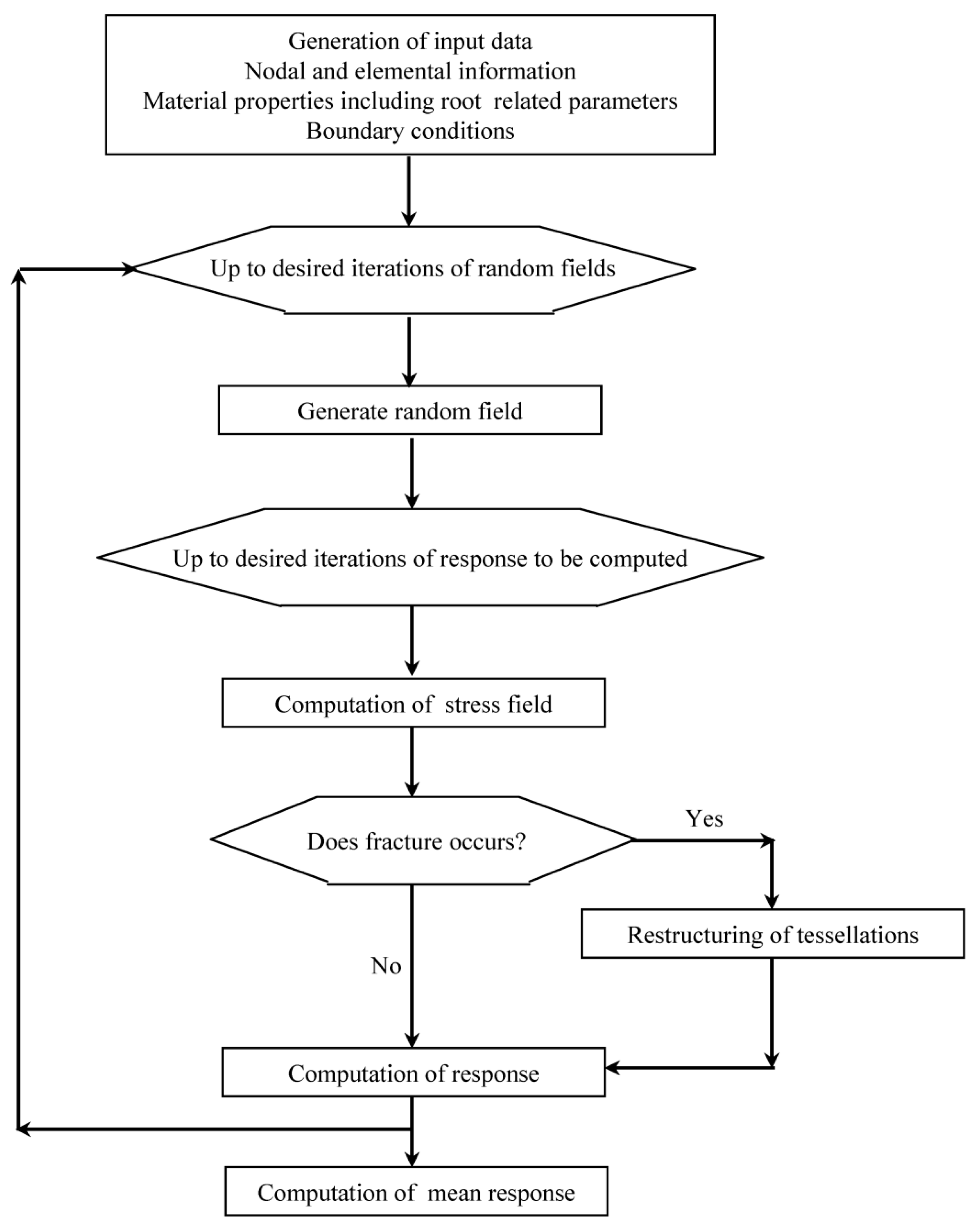
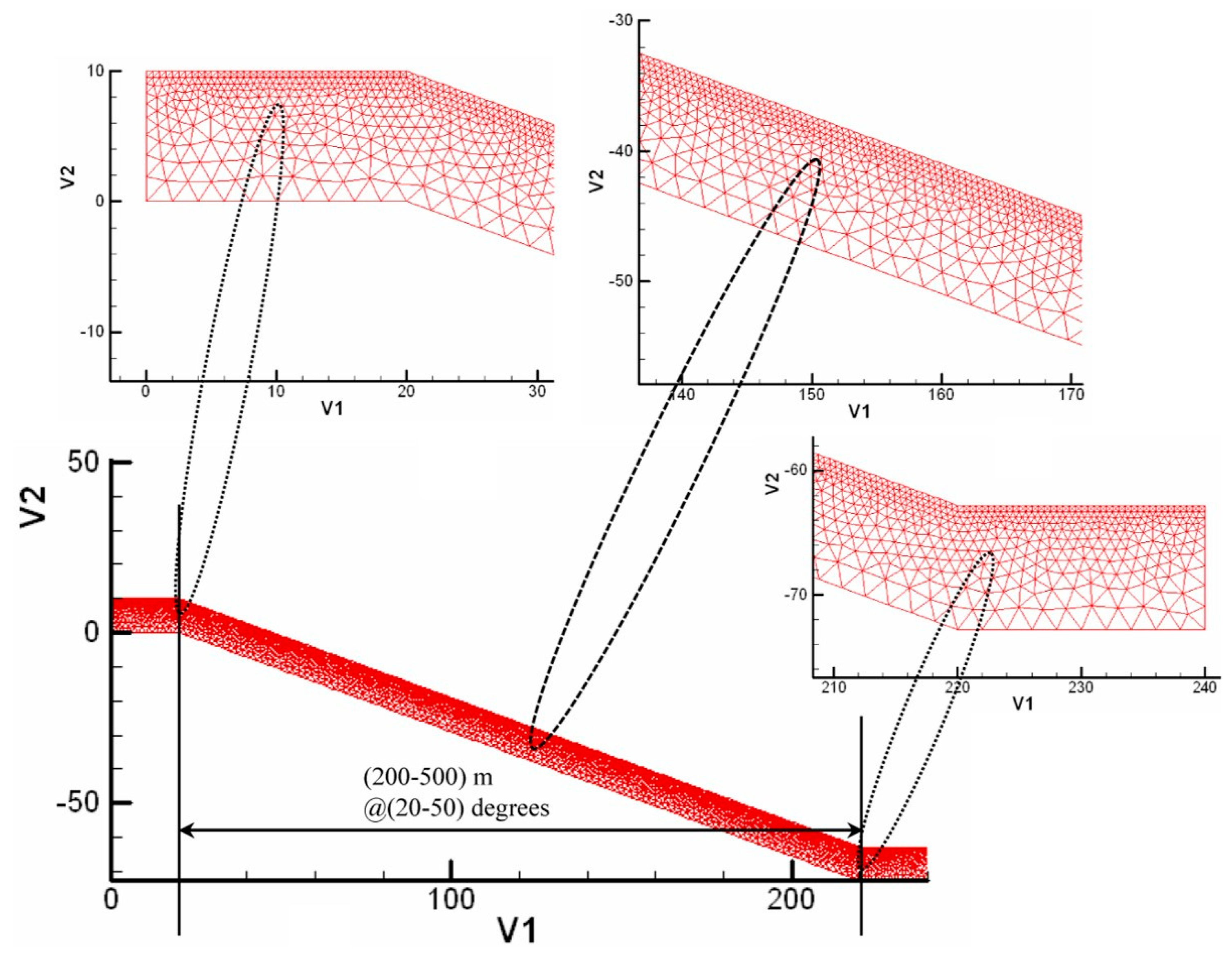

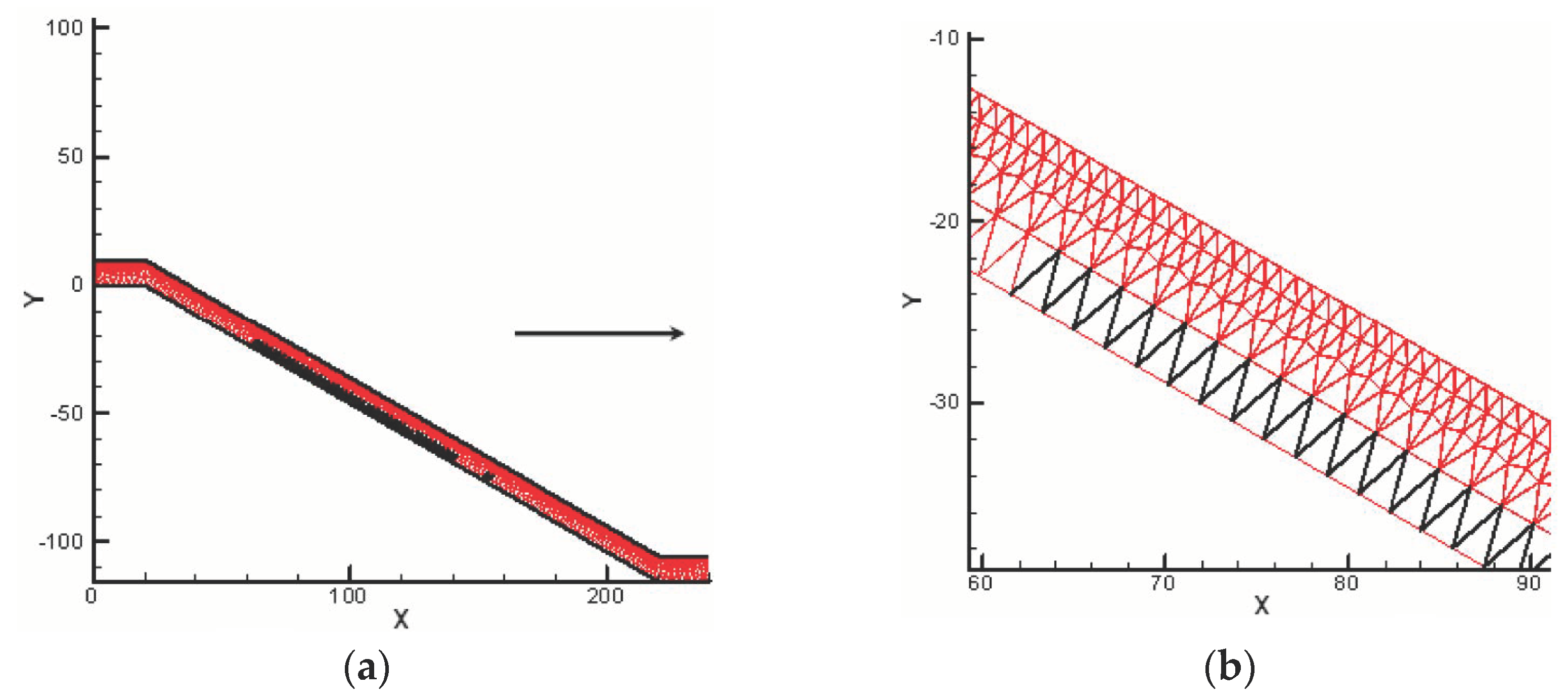

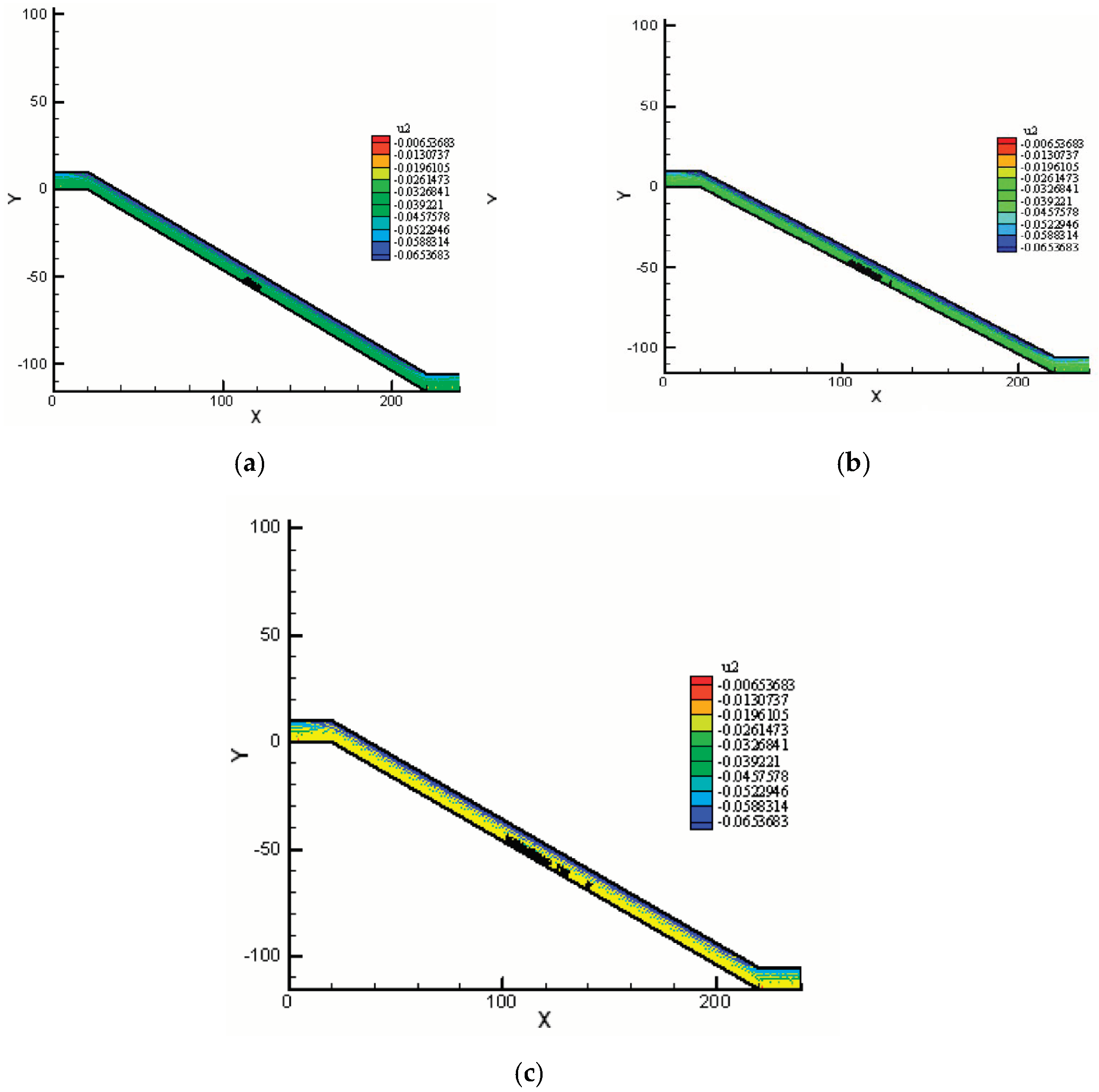
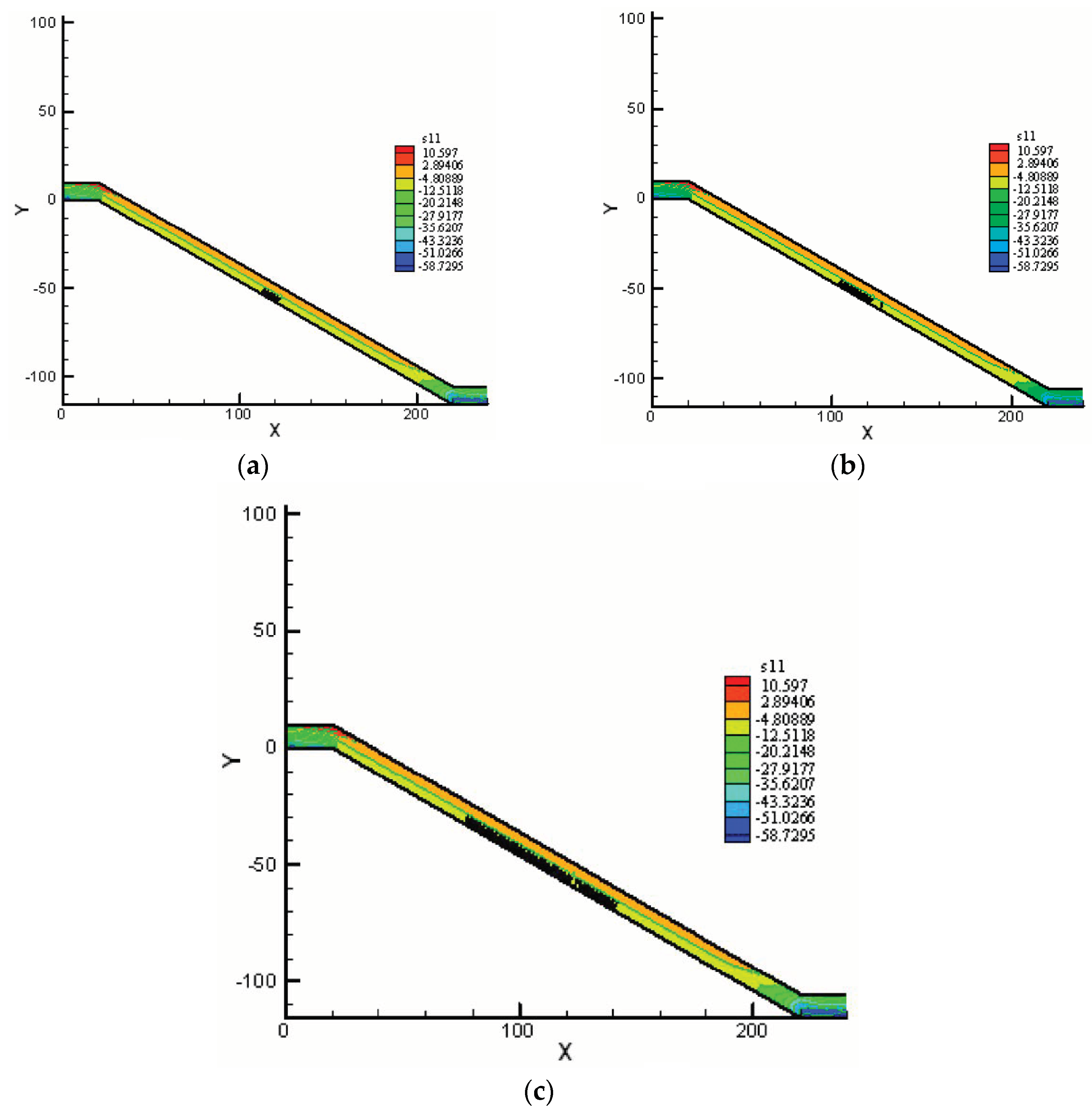
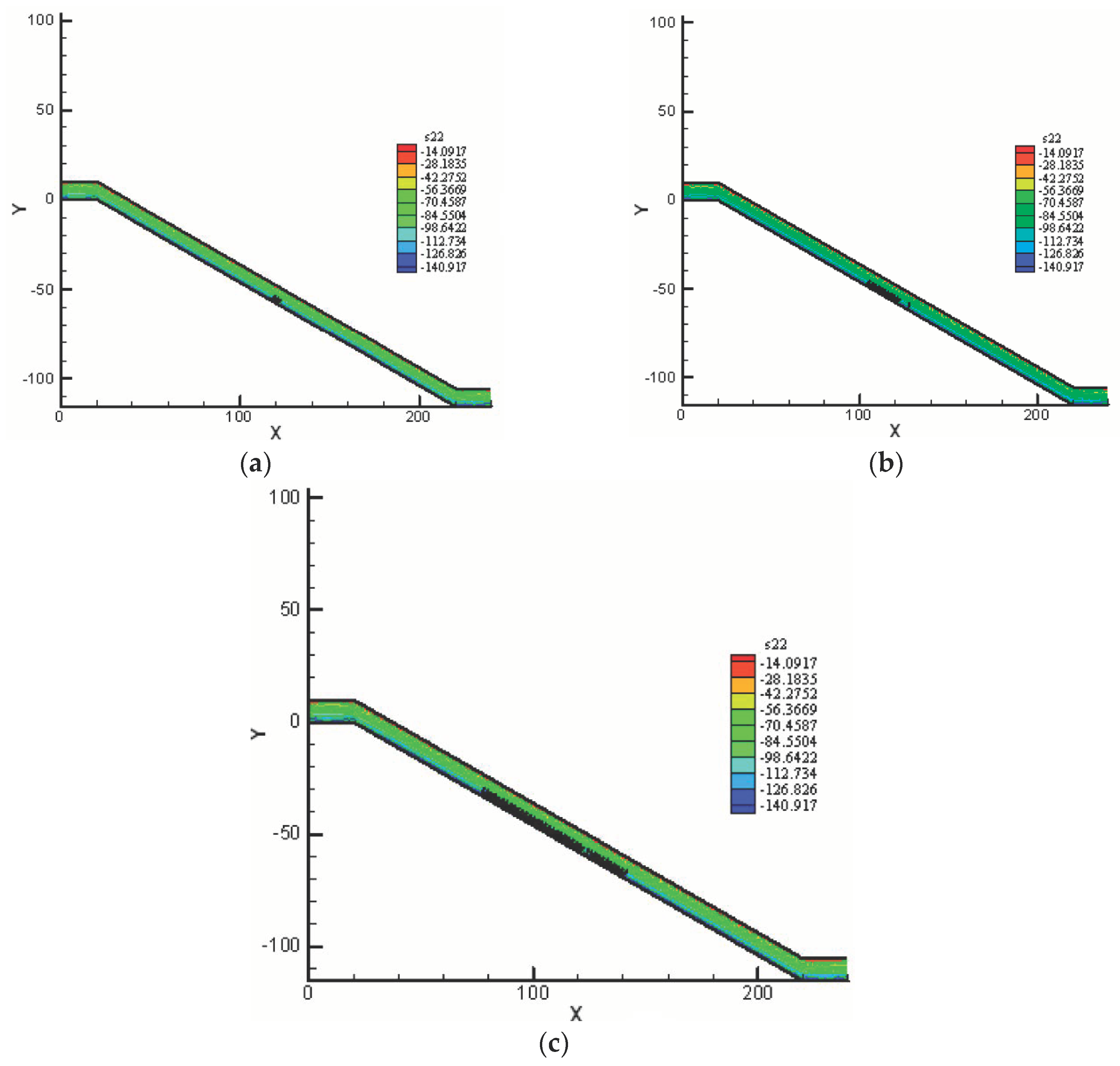
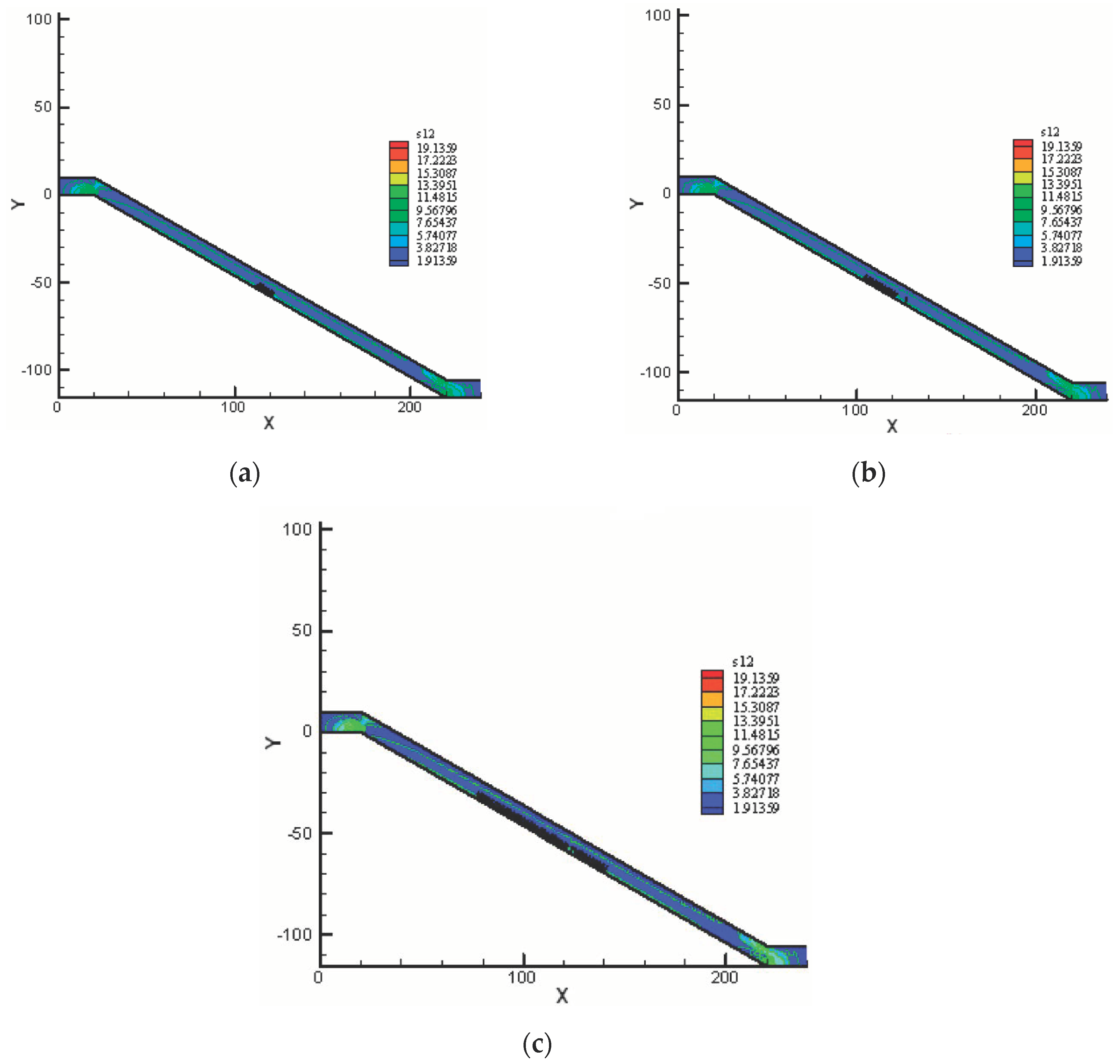
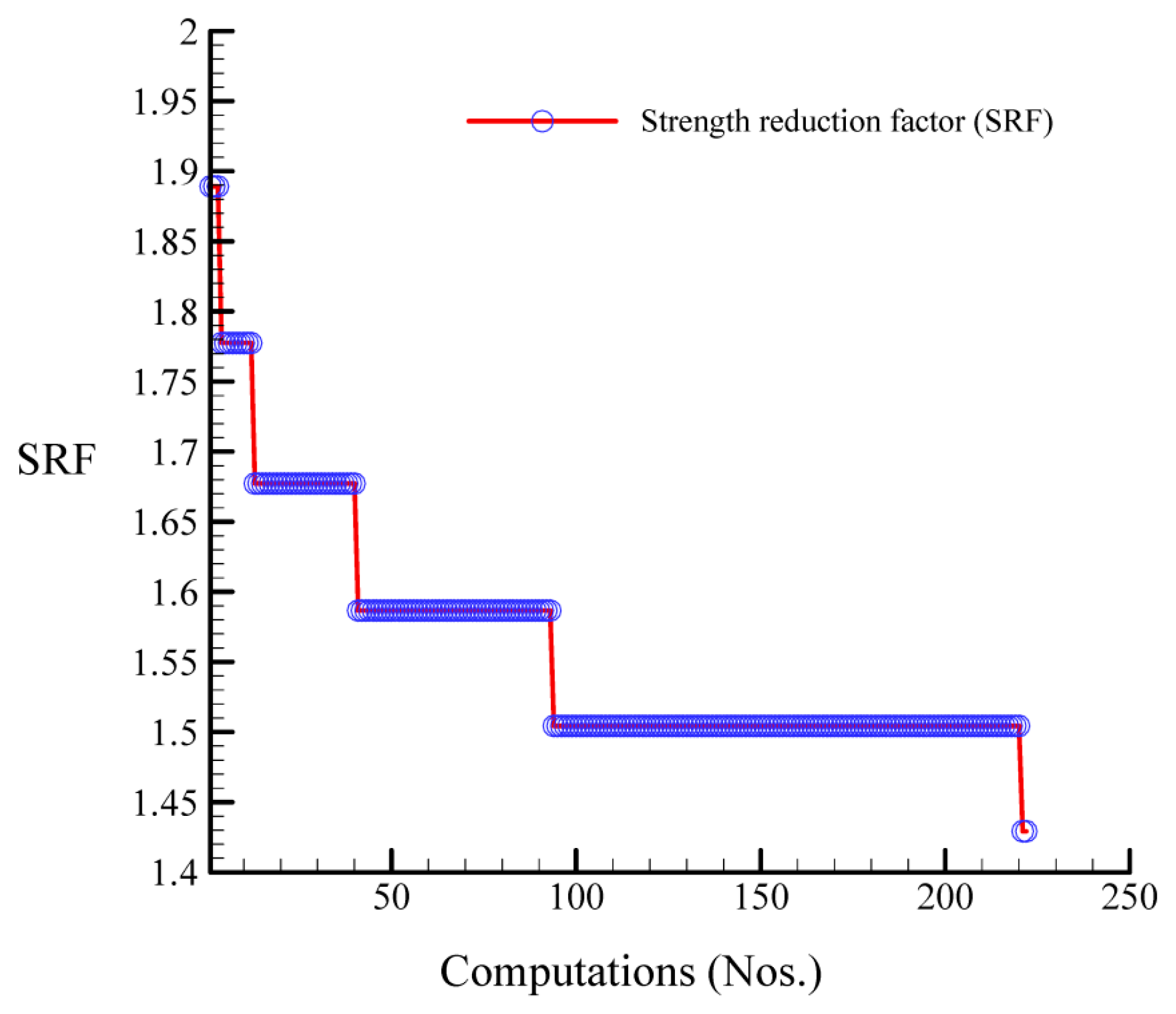
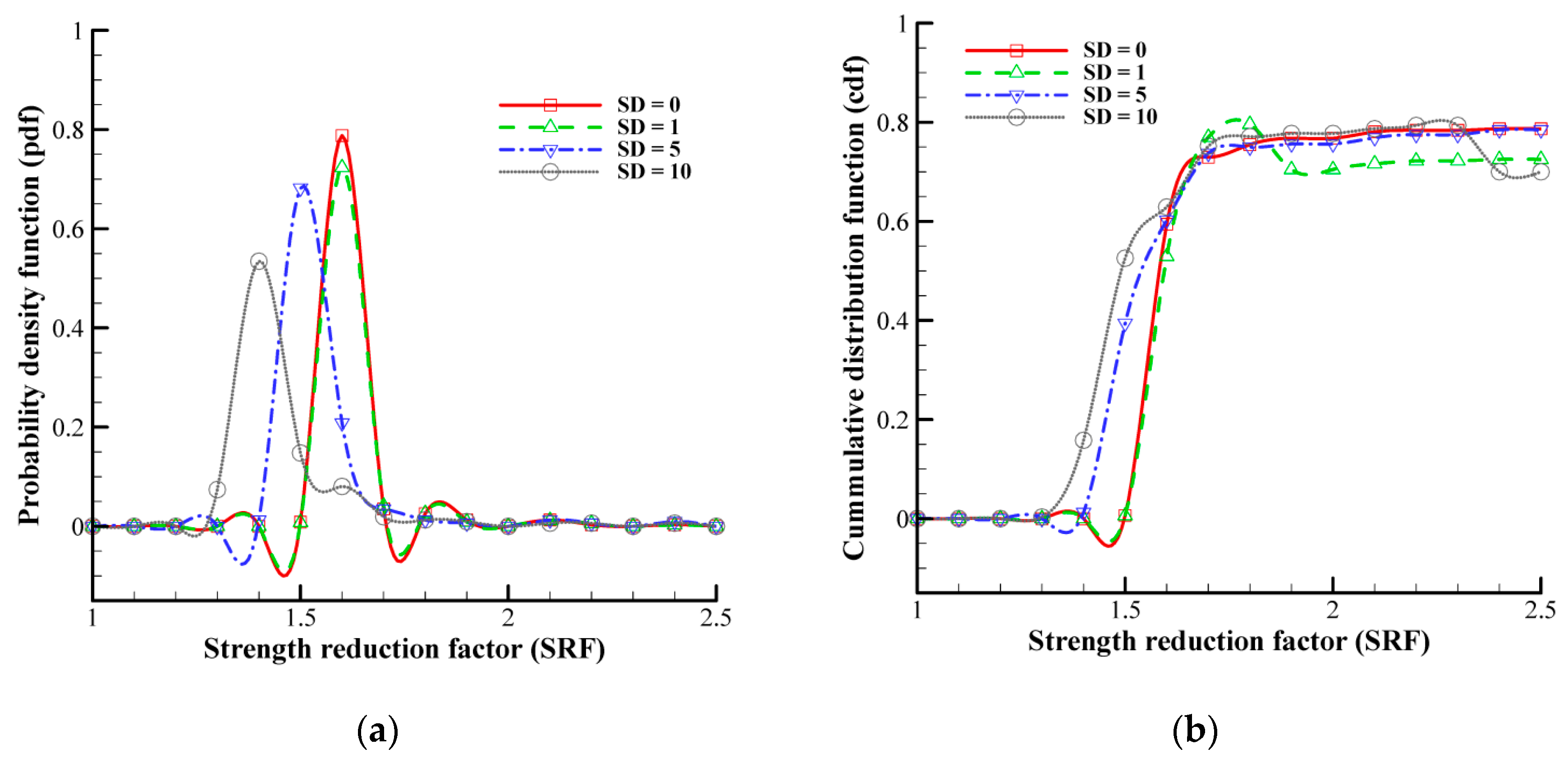


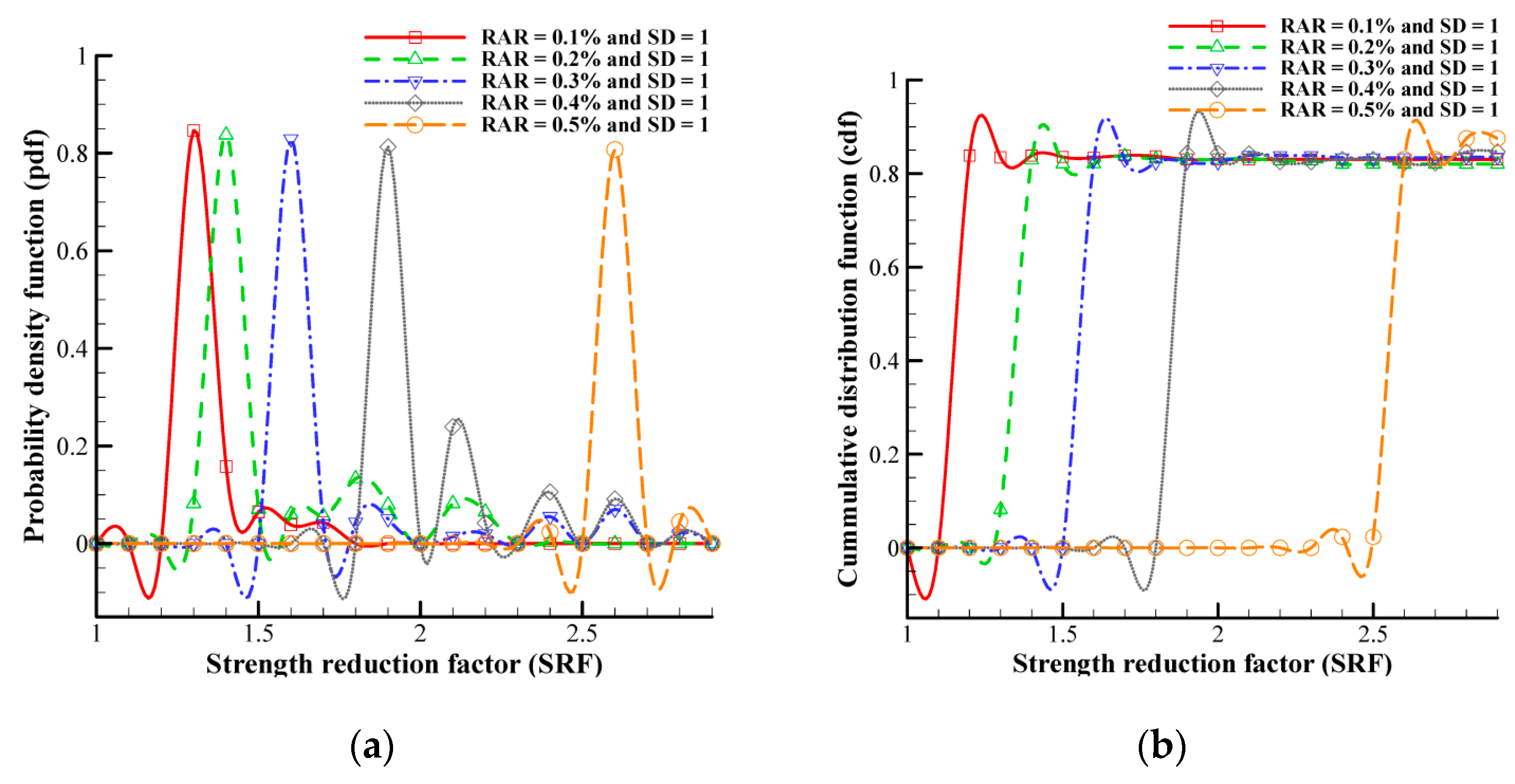
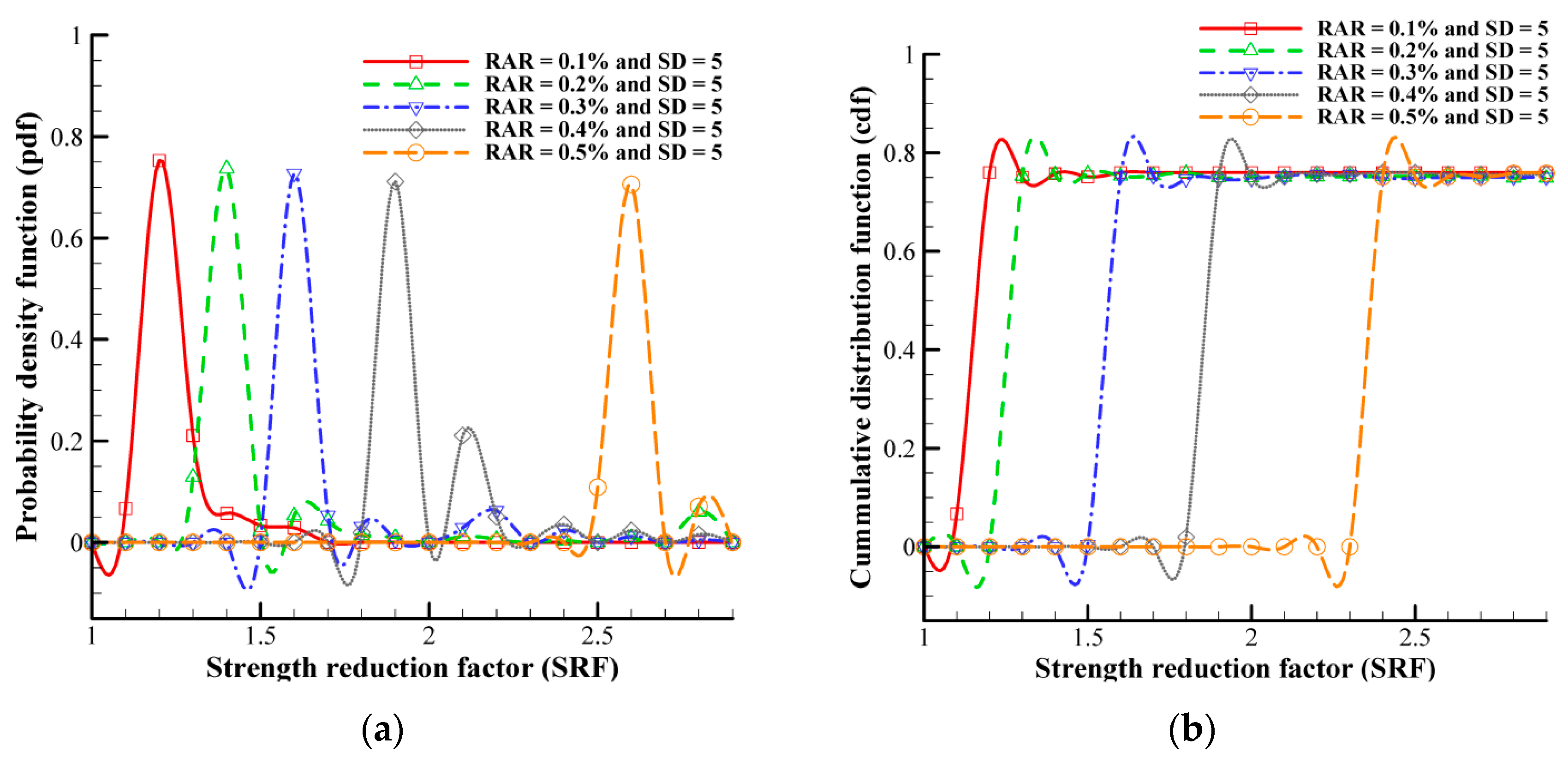
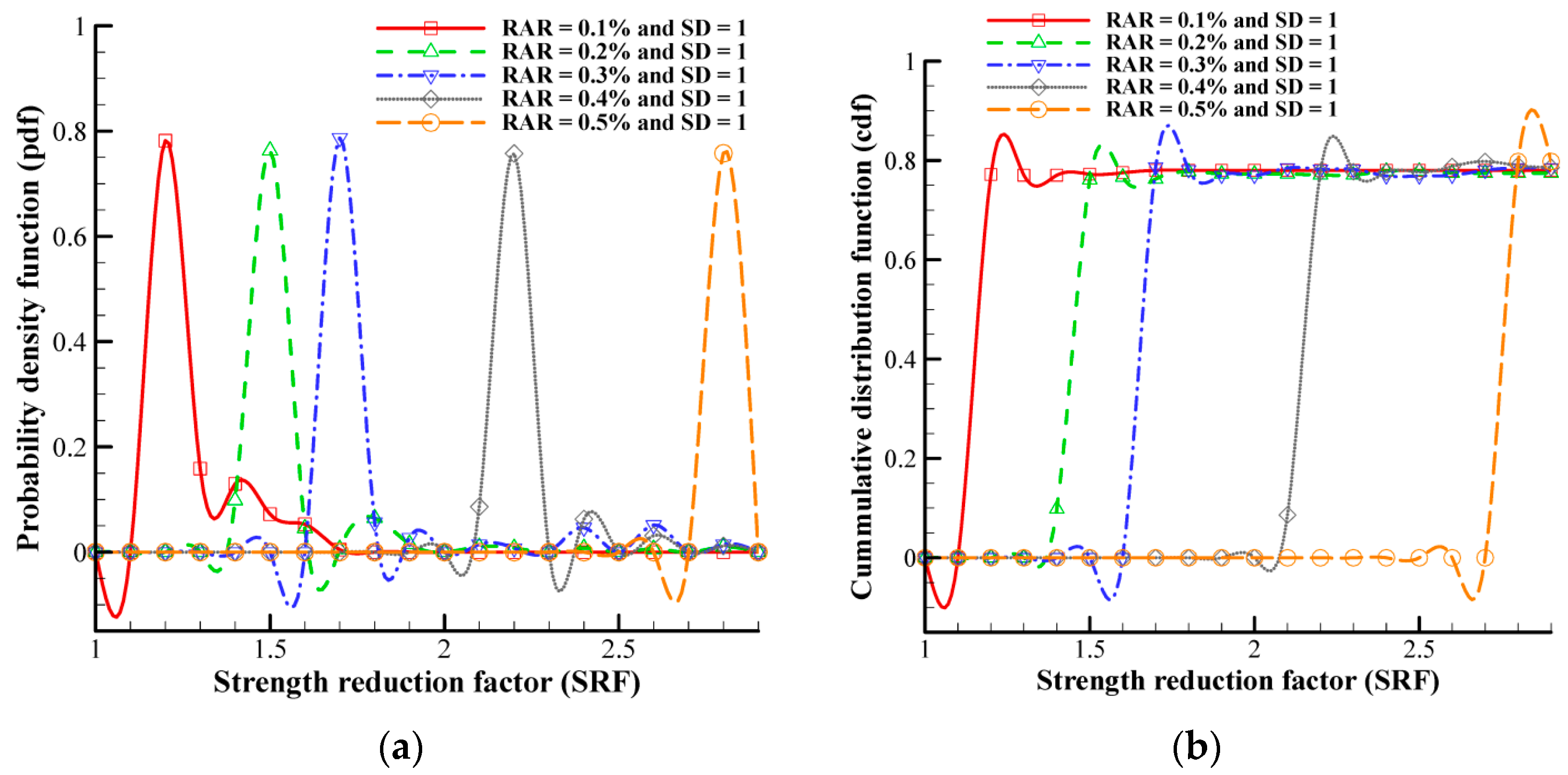
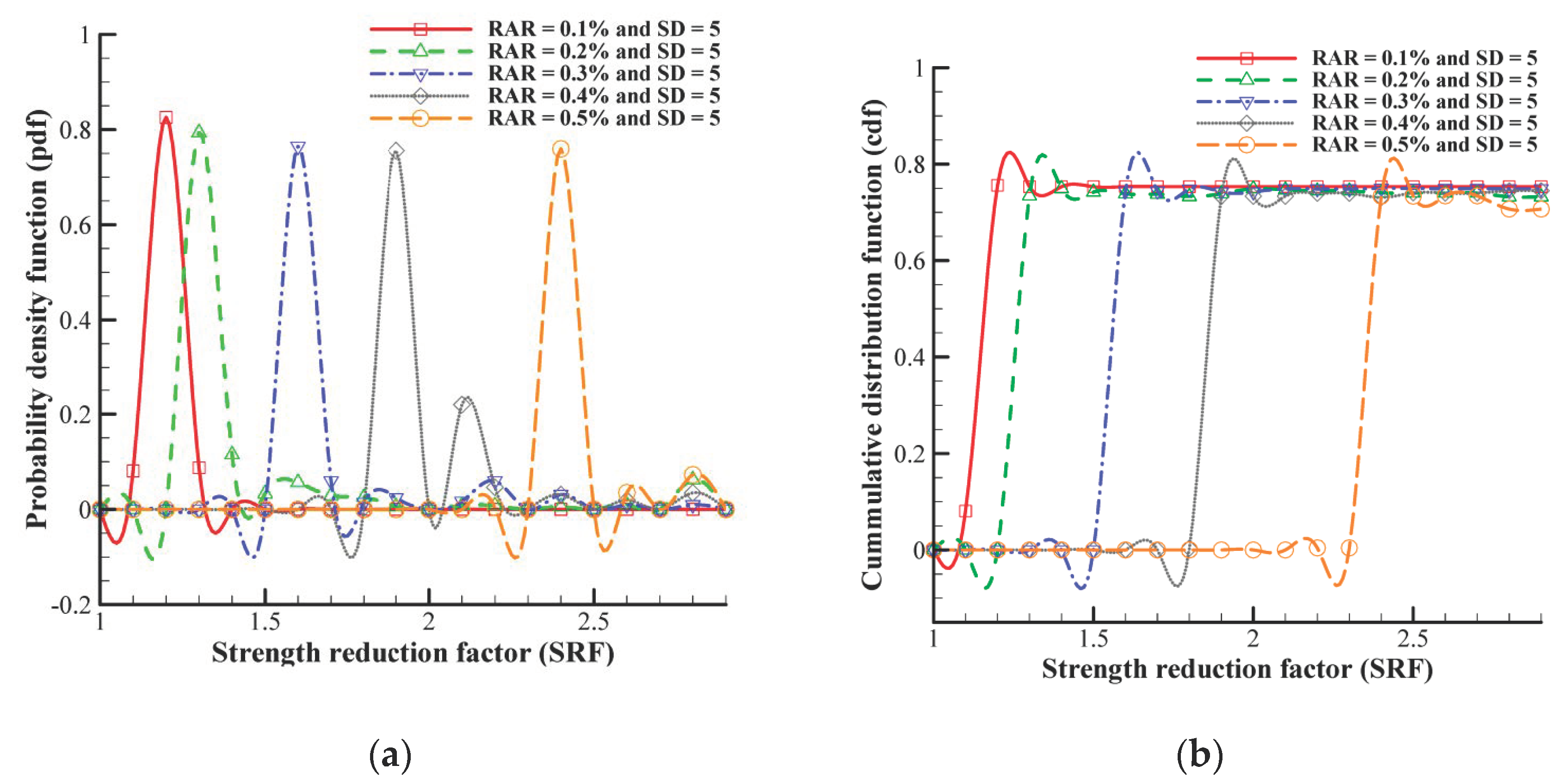
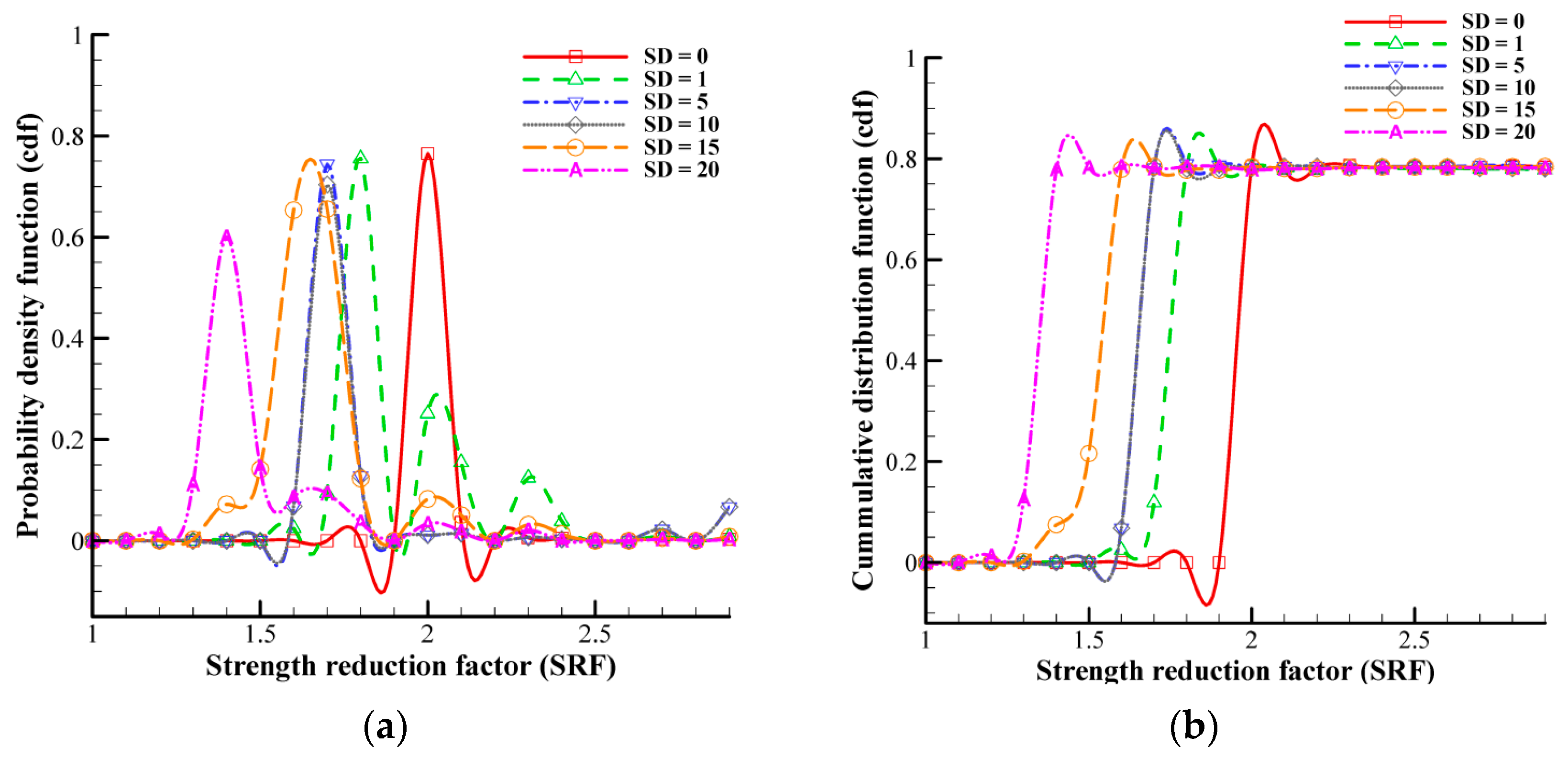
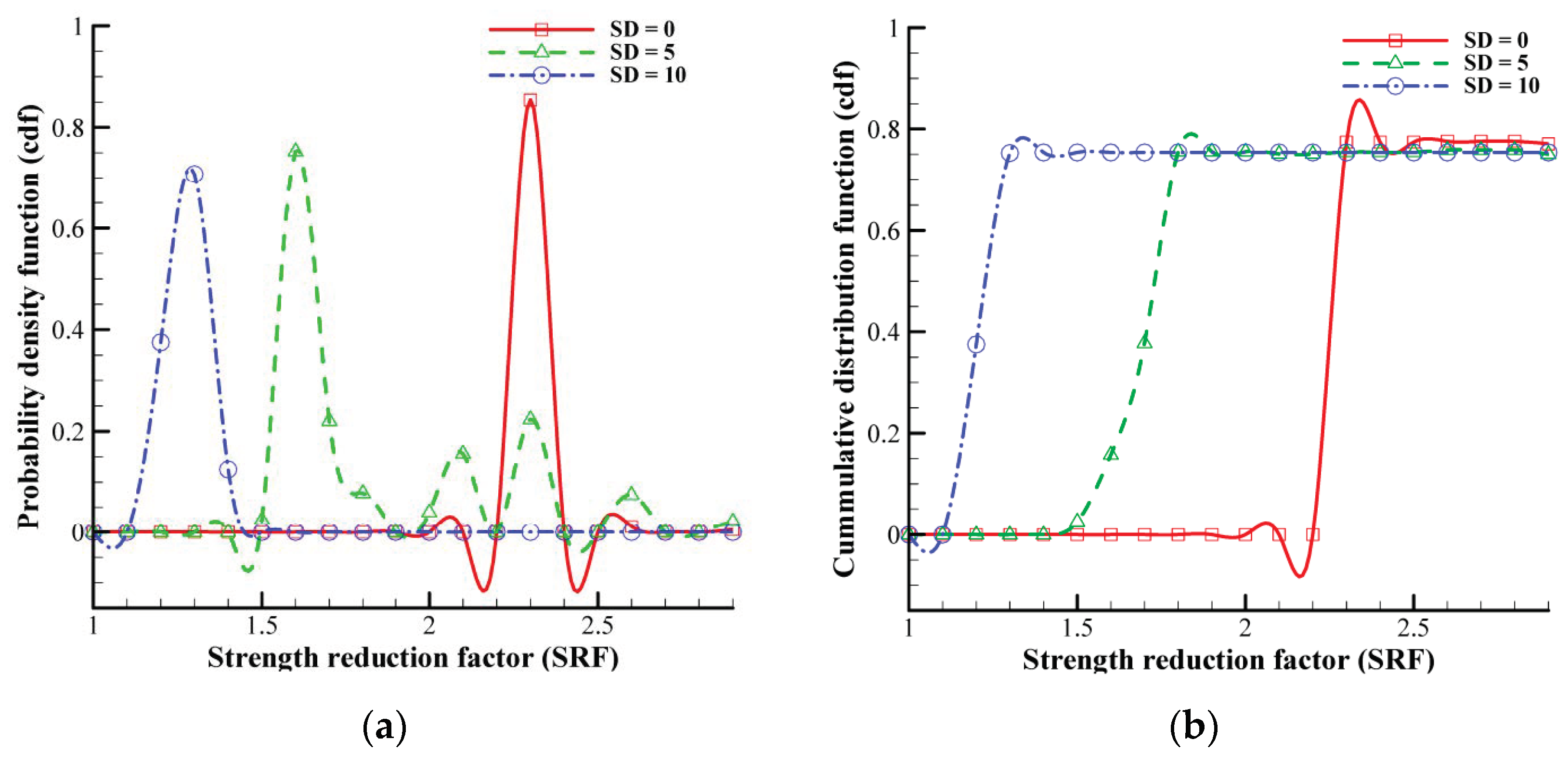

Disclaimer/Publisher’s Note: The statements, opinions and data contained in all publications are solely those of the individual author(s) and contributor(s) and not of MDPI and/or the editor(s). MDPI and/or the editor(s) disclaim responsibility for any injury to people or property resulting from any ideas, methods, instructions or products referred to in the content. |
© 2023 by the authors. Licensee MDPI, Basel, Switzerland. This article is an open access article distributed under the terms and conditions of the Creative Commons Attribution (CC BY) license (https://creativecommons.org/licenses/by/4.0/).
Share and Cite
Tiwari, R.C.; Bhandary, N.P. Stochastic Finite Element Analysis of Root-Reinforcement Effects in Long and Steep Slopes. Geotechnics 2023, 3, 829-853. https://doi.org/10.3390/geotechnics3030045
Tiwari RC, Bhandary NP. Stochastic Finite Element Analysis of Root-Reinforcement Effects in Long and Steep Slopes. Geotechnics. 2023; 3(3):829-853. https://doi.org/10.3390/geotechnics3030045
Chicago/Turabian StyleTiwari, Ram Chandra, and Netra Prakash Bhandary. 2023. "Stochastic Finite Element Analysis of Root-Reinforcement Effects in Long and Steep Slopes" Geotechnics 3, no. 3: 829-853. https://doi.org/10.3390/geotechnics3030045








